
"Private Music School"
at Jakobskirken, Nørrebrogade 67, Esbjerg 6700
The instruments and Level are:
1- Classical Piano
The purpose of piano lessons is to develop the student's instrument mastery
and musical understanding. This lays the foundation for musical enjoyment, artistic experience and personal development.
The lessons are individually planned for each student.
Beginner lessons are based on creating familiarity with the basic elements of piano playing: the structure of the piano, technique, sheet music, chords, ear training, practice habits, etc.
Later, the content of the lessons will typically be more tailored to the individual student's abilities and interests.
The student must have their own piano.
2- Keyboard
A keyboard is a type of electric piano with the option of adding automatic accompaniment in the left hand, with a rhythm box, etc. The instrument usually has built-in speakers, and it is also possible to connect headphones so that you can sit and practice in peace. Of related instruments, there is the slightly more expensive synthesizer, where you can create your own sounds.
Through practical musical examples, we expand our knowledge of key and note names, fingering, notation, accompaniment, bass lines, improvisation and professional tips. For advanced students, there is also the opportunity to work with basic arrangements and recording on a computer, for example of the student's own compositions.
The student must have their own keyboard.
3- Classical Guitar
The lessons take place either in groups or as individual lessons. You come to class once a week, and you must have time to practice daily at home to benefit from the each class.
The lessons can be used at all levels.
You can start playing guitar from the age of 6, starting with a small guitar.
The student must have their own guitar.
4- Electric Guitar
The lessons can be used at all levels, regardless of whether you want to learn a few chords for your own pleasure or have ambitions for a possible later professional musical education or career.
You can start playing guitar as early as 6 years old, starting with a small guitar and electric guitar from the age of 10.
The student must have their own electric guitar.
5- Trumpet
The trumpet is a widely used instrument in both classical and rhythmic music.
The teaching is based on the student's level.
It is never too late to start playing the trumpet.
We take beginners, intermediate and advanced students.
The student must have their own trumpet.
6- Saxophone
You can usually start playing the saxophone at the age of 7-9, depending on the size of your fingers. It is advantageous to start playing the recorder, as the grips are very similar and then switch when physics allows it.
There are 4 saxophone sizes (soprano, alto, tenor and baritone).
You usually start with an alto or tenor saxophone.
We take beginners, intermediate and advanced students.
The student must have their own saxophone.
7- Rhythmic Singing
Rhythmic singing lessons are given to both beginners and advanced students.
The starting point is always the student's level, and it is never too late to start singing.
Content of singing lessons:
The voice is trained through breathing and singing exercises. This is done partly to expand the range of the voice and develop the sense of timbre, and partly to sharpen the feeling for singing cleanly. After the warm-up (voice training), the repertoire that the student and teacher have found suitable is sung, and within which phrasing, improvisation and textual and musical expression are worked on. The lessons in rhythmic singing include microphone technique. Knowledge of sheet music is not a requirement, but is an advantage for independent practice.

